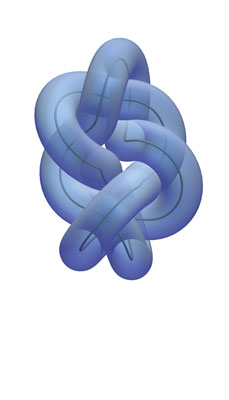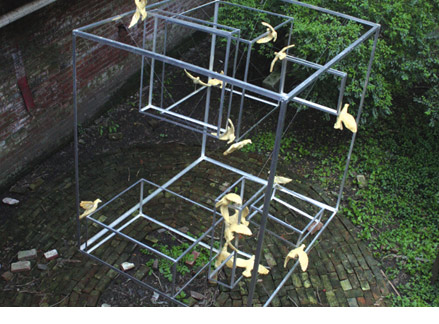


The Art of the Algorithm
by Laurie Anderson


Recent visitors to an outdoor art installation in Athens, GA, probably didn’t know they were looking at the visual expression of a math concept. The eight-foot cubic sculpture, standing in an outdoor courtyard, held life-size models of pigeons scattered within a series of nested aluminum frames. It looked more like a comment on man and nature than an algorithmic process. It was, however, created by UGA mathematician Jason Cantarella and his brother Luke, a scenic designer, to illustrate the mathematical concept of the octant-tree, or octree.
An octree “is a method for dividing a collection of points in space into smaller and smaller groups, organized by their location,” said Cantarella. “The boxes formed by the frames divide the birds into up-down, left-right and front-back groups.” An observer can locate groups of the birds or individual birds quickly by referring to their placement within particular frames, more quickly than if the birds were freely suspended in mid-air. The brothers playfully dubbed their creation a “flocktree.”
Pigeons appear to flutter through a “flocktree,” a sculptural
representation of the mathematical concept of an octree.

“As the number of things in an area increases, it gets more difficult to separate them into groups,” pointed out Cantarella. “Imagine that you're watching a park fill up with people waiting for an outdoor concert. At first, they arrive in parties of three or four and it's easy to for your eye to group them together: the couple sitting a little apart from everyone, the noisy gaggle of teenagers, the parents with small children. But as the park gets more crowded, it gets more difficult to keep the groups separated, and eventually you find yourself just looking at a mass of ‘crowd,’ every so often zooming in on someone who stands out in some way. Somewhere in the middle of this process there’s a really interesting density at which you still want to group the things you’re looking at, but there isn’t an obvious way to do it.”
The flocktree presents one such arrangement, said Cantarella—a flock of pigeons, frozen in position—and asks the viewer to make sense of it visually. “Is the very logical, understandable way of grouping the birds indicated by the aluminum cages really satisfying to your eye?” asks the mathematician. “For me, the boxes are something of a tease—it’s clear that they aren’t random, but I have to think about how they are placed!”
Octree-based algorithms and their descendents have been useful in developing efficient computer codes. Cantarella and mathematics doctoral student Ted Ashton recently used such an algorithm to build part of a program they created with Eric Rawdon of the University of St. Thomas and Michael Piatek of the University of Washington. The program, called RidgeRunner, is the first of its kind to model and visualize the tightening of knots, said Cantarella. The program can find the smallest length at which any given knot can exist. This minimal length shape is known as a “tight knot.”
Cantarella and his students are using it to help physicists Thomas Kephart of Vanderbilt University and Roman Buniy of the University of Oregon study subatomic particles called glueballs, which they theorize form as very tight flux knots.
“Glueballs appear to form like a very turbulent flow of water, like water you’d see in a blender swirling in a particular intercrossing way,” explained Cantarella. “A knotted path of this energy flow, or flux, is what Kephart and Buniy are detecting.”
“The length of time glueballs exist appears to correspond to their level of complexity, which in turn appears to relate directly to the complexity of various tight knots,” said Kephart. “The energy level itself is what we are identifying with knot type.” If correct, scientists will be able to predict glueball masses, added Kephart, “because these masses correspond to knot lengths found by the RidgeRunner program.”
As with the flocktree, the math behind the knot-tightening creates striking visuals, too.
“One of the frustrations of being a scientist is that you’re surrounded by ideas that are just beautiful, but it's very difficult to share them with anyone else,” said Cantarella.
“Interestingly, not many people who see the flocktree installation seem concerned with the science,” he said of the project, which was funded in part by a grant from Ideas for Creative Exploration (ICE), an interdisciplinary initiative for advanced research in the arts at the University of Georgia. When viewers discover how the framework can be used to organize the pigeons, though, Cantarella observed, “they are pleasantly surprised.”
“The flocktree was our way to take an idea that makes immediate sense to computer programmers and try to make it meaningful in a larger context. In that sense, the algorithm was art before we started our work.”
For more information contact Jason Cantarella at jason.cantarella@gmail.com.
For comments or for information please e-mail: rcomm@uga.edu
To contact the webmaster please email: ovprweb@uga.edu
![]()